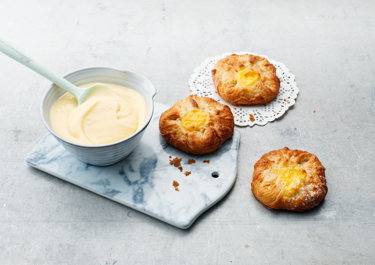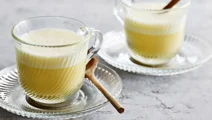
Crème anglaise

Instructions
Tip
Be careful not to overcook the creme anglaise. When you heat the mixture, be sure to whisk constantly at a low to medium heat.
Tip
Try adding different types of flavour components like orange zest. This will give the crème anglaise new and flavourful dimensions.
Crème anglaise
Ingredients
|
Vanilla pod
|
1 |
|---|---|
|
Milk
|
600 ml |
|
Caster sugar
|
1¼ dl |
|
Corn starch
|
75 g |
|
Egg yolks
|
6 |
|
Butter, in pieces
|
50 g |
Crème anglaise – instead of custard in cakes and pastries
No matter what you call it, a sweet and creamy vanilla sauce is often the finishing touch that elevates a dessert, pastry, or cake. Crème anglaise can be thought of as a thin pouring custard, eaten as a dessert or poured on berries and pies. Our version is a bit thicker, bringing it closer to a crème pâtissière, or pastry cream. This makes it ideal for spreading between cake layers or for piping into pastries. And as fancy as it sounds, this crème anglaise is quick and easy to make.
Why homemade vanilla crème anglaise is the best
Store-bought custard or powder mix can be a welcome shortcut in the kitchen. But they will never beat the flavour and texture of a crème anglaise, made from scratch and fresh from the hob. By sourcing your own ingredients and making the cream yourself, you get full control and can ensure that flavour and texture are just right. The whole process only takes marginally longer than working with a powder mix. And of course, nothing beats the feeling of serving a silky-smooth crème anglaise with the words “I made this myself.”
How to store vanilla crème anglaise
If you have leftover crème anglaise, or if you made a batch in advance, simply pop it in the fridge in an airtight container. It should keep for up to five days. If you want to serve the crème warm, reheat it gently over low heat in a saucepan, stirring continuously to make sure that the egg yolks do not curdle.










&format=webp)